INDEPENDENT DEALER
Wichita, KS | (316) 686-1069
OUR BLOG
Maintaining an electric vehicle is simpler than maintaining a traditional car, but it still requires attention. Learn the ins and outs of how to maintain an electric vehicle with this post by Hartmans Inc in Wichita, KS.

Electric vehicles (EVs) are revolutionizing the way we drive, offering quieter performance, instant torque, and environmental benefits. But just because EVs have fewer moving parts than gasoline-powered cars doesn’t mean they’re maintenance-free. Like any machine, EVs need proper care to stay in top shape.
Whether you're a new EV owner or considering the switch, this guide breaks down how to maintain an electric vehicle—and how it differs from traditional car maintenance.
Once you learn how to maintain an electric vehicle, call Hartmans Inc in Wichita, KS at (316) 686-1069 or visit AMSOIL’s online store to find the products you need for your car’s upkeep.
How to Maintain an Electric Vehicle
Why EV Maintenance Is Different
Electric vehicles don’t use internal combustion engines, so they don’t need oil changes, spark plugs, fuel filters, or timing belts. Fewer mechanical components generally mean fewer things can go wrong. That also translates into lower long-term maintenance costs.
However, EVs do have systems that need regular attention, including the battery, brakes, tires, and software. Let’s take a closer look.
1. Battery Maintenance and Care
The battery pack is the heart of an electric vehicle and the most expensive component. While modern EV batteries are designed to last hundreds of thousands of miles, proper habits can help extend their lifespan:
- Avoid frequent fast charging when possible, as it generates more heat and can wear down the battery over time.
- Don’t let the battery sit at 0% or 100% for extended periods. Try to keep the charge between 20–80% for daily driving.
- Park in the shade or a garage to minimize heat exposure, especially during hot weather.
- Follow any software updates or guidance from your manufacturer regarding battery conditioning.
Most EVs have thermal management systems to regulate battery temperature, but your charging habits and environment still make a difference.
2. Tire Maintenance
Tires on electric vehicles wear differently than on gas-powered cars. EVs are heavier due to the battery, and they deliver instant torque, which can put more strain on tires.
- Check tire pressure monthly, as low pressure reduces range and increases wear.
- Rotate your tires regularly, usually every 5,000–7,500 miles.
- Consider buying EV-rated tires, which are designed to handle the extra weight and performance characteristics of electric vehicles.
Proper tire care helps maintain driving efficiency, ride quality, and battery range.
3. Brake System Check-Ups
EVs use regenerative braking, which recaptures energy and feeds it back to the battery. This reduces wear on brake pads and rotors, meaning you may not need to replace them as often as in a gas car.
That said, brakes can still corrode from lack of use—especially in wet climates—so regular inspections are important. Most manufacturers recommend a brake system check every 12 months or 12,000 miles.
Brake fluid replacements are also a requirement! AMSOIL DOT 3 and DOT 4 100% Synthetic Brake Fluid will help protect your braking system and keep it working as expected.
4. Cooling System and Fluids
Yes, EVs still need some fluids—just not engine oil.
- Coolant is required to regulate battery, inverter, and motor temperature. Check the coolant levels periodically and flush the system as specified by the manufacturer.
- Brake fluid should be tested and replaced every 2–3 years.
- Windshield washer fluid still applies—just like in any other car.
Some EVs also have transmission fluid for the reduction gear. Refer to the owner’s manual for any scheduled changes.
5. Software Updates and Diagnostics
One of the most unique aspects of owning an EV is over-the-air (OTA) software updates. Automakers like Tesla, Ford, and Hyundai regularly release updates that improve efficiency, add features, or fix bugs.
- Enable automatic updates if your car supports it.
- Visit the dealership or service center for system diagnostics or if an update fails.
Keeping software current ensures optimal performance and safety.
6. Cabin Air Filter and HVAC
Most EVs have cabin air filters that need to be replaced every 15,000–30,000 miles. These filters keep dust, pollen, and debris out of the ventilation system.
Also, pay attention to the climate control system, especially if it’s used to precondition the battery. Regular HVAC service may be required to keep everything working efficiently.